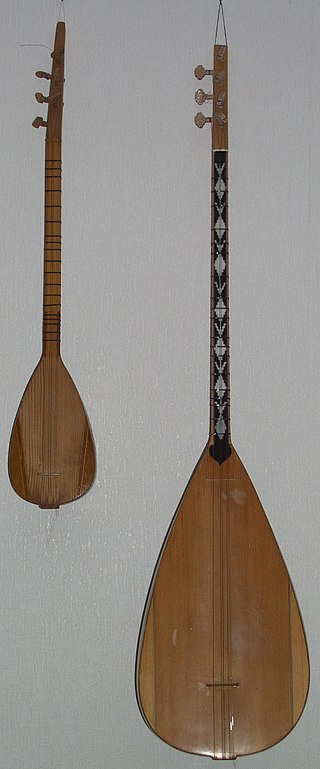Top Qs
Timeline
Chat
Perspective
Bağlama
Stringed musical instrument From Wikipedia, the free encyclopedia
Remove ads
The bağlama or saz is a family of plucked string instruments and long-necked lutes used in Asia, Central-Asia, Caucasus, Anatolia, Levant, Thrace, Balkans and Europe. It is commonly used in Iranian, Armenian, Azerbaijani and Turkish Folk Music. It is a common instrument among Turkic people and a notable instrument of traditional folk artists like ashiks and ozans. It is both used as a solo instrument to play songs and to accompany türkü, traditional folk songs.
Remove ads
Name
According to The New Grove Dictionary of Music and Musicians, "the terms 'bağlama' and 'saz' are used somewhat interchangeably in Turkey. 'Saz' is generally used interchangeably with 'enstrüman' (instrument) and it is used to refer single or group of musical instruments like 'üflemeli sazlar' (wind instruments).[1]
Bağlama scale
The musical scale of the bağlama differs from that of many western instruments – such as the guitar – in that it features ratios that are close to quarter tones. The traditional ratios for bağlama frets are listed by Yalçın Tura:[2]
- Fret 1: 18/17
- Fret 2: 12/11
- Fret 3: 9/8
- Fret 4: 81/68
- Fret 5: 27/22
- Fret 6: 81/64
- Fret 7: 4/3
- Fret 8: 24/17
- Fret 9: 16/11
- Fret 10: 3/2
- Fret 11: 27/17
- Fret 12: 18/11
- Fret 13: 27/16
- Fret 14: 16/9
- Fret 15: 32/17
- Fret 16: 64/33
- Fret 17: 2/1
However, as confirmed by Okan Öztürk,[3] instrument makers now often set frets on the bağlama with the aid of fret calculators[4] and tuners based on the 24-tone equal temperament. The frets include the 12 tones within 12-tone equal temperament, along with 5 more. This means that 12 tone songs can be played on the Bağlama.
Remove ads
Notable performers


- Aşık Veysel (1894–1973)
- Muharrem Ertaş (1913–1984)
- Neşet Ertaş (1938–2012)
- Musa Eroğlu (1945–)
- Orhan Gencebay
- Arif Sağ (1946–)
- Nida Tüfekçi
- Orhan Ölmez
- Aşık Mahzuni Şerif (1940–2002)
- Nuray Hafiftaş (1964–2018)
See also
- Alevism
- Art of Azerbaijani Ashiqs
- Baglamas
- Bouzouki (Greece)
- Buzuq (Lebanon & Syria)
- Çiftelia
- Dombra
- Dutar
- Innaby, Azerbaijani dance
- Komuz
- Music of Turkey
- Sallaneh (lute)
- Šargija
- Setar
- Tambura (instrument)
- Tanbur
References
External links
Wikiwand - on
Seamless Wikipedia browsing. On steroids.
Remove ads

